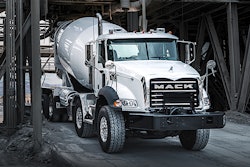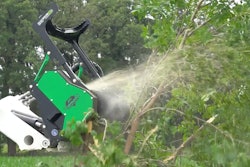
While much of the sleeper-cab used truck market was spiraling downward earlier this year, used vocational trucks have been a steady bright spot for truck dealers.
“Used vocational trucks are strong,” says Craig Kendall, specialty markets manager for The Pete Store and current Used Truck Association president. “We are encouraged by this market, but we’re not quite at pre-recession levels.”
“As a group, used Class 8 straight trucks (excluding tractors), were up 5 percent in 2016 through April 2017,” says Steve Tam, vice president of ACT Research, a market intelligence firm that tracks highway vehicles. “They did much better than their sleeper counterparts, which were down 10 percent or more but are now finally starting to brighten.”
Taking a deeper dive into his numbers, Tam says he was surprised to see that dump trucks were down within this vocational slice, especially compared with crane, mixer and vacuum trucks. “Dumps usually tend to be rainmakers for dealers, so I’m not sure what’s driving that,” he says. “The demand is sure strong, so it could be a repositioning.”
In contrast to dumps, truck-mounted cranes were up 30 percent during the 16-month period, which Tam says could mean the energy sector’s pulse is reviving. “Oil field players are now back in the market and looking at the supply of used trucks,” he says. Kendall says he’s heard of a 100-unit new truck buy from a fracking client, another sign the energy sector is picking up. During the same 16-month period, mixers were up 25 percent and vacuum trucks were up 15 percent.
“In general, it’s a buyer’s market,” Tam says. “With prices being down, you can save money and buy younger used equipment. I think it would behoove the potential buyer to take a look at the used truck market right now.”
Since new truck sales eventually drive used sales, Tam also sees growth instead of replacement being the primary new truck sales driver. “My sense is that for every 10 new trucks people buy, they are only sending one to the used truck market,” he says. “That would suggest a smaller supply and equivalent demand on the used side in the future. So if you’re going to buy, the sooner the better, because it looks like the market will tighten up.”
Pre-emission premiums
“While we did see some softening of truck prices in second through fourth quarter of 2016, we have seen a slight uptick in prices in early 2017 across all makes and models,” says Doug Olive, senior vice president, pricing, at Ritchie Bros. “In particular, we continue to see strong demand for most pre-emission trucks – 2007 model year and older – specifically ‘long-n’ talls’ with C15 power.”
Heavy trucks were three to four years ahead of off-road equipment in deploying SCR (selective catalytic reduction) technology to reduce engine emissions. By 2011, most truck engines were using these more expensive systems, and as a result, lower mileage trucks built in model years 2006 through 2009 are enjoying a price premium on the used market.
“That never used to happen,” says Brian Sandon, eastern U.S. sales manager, J.J. Kane Auctioneers. Buyers have concerns about the reliability and longevity of the new emissions systems. And contractors may be worried about their inability to fix or work on these complicated new engines. “You have to have a lot of investment – tools and scanners – and a lot of smaller contractors don’t have that ability,” Sandon says.
Olive points out another change in the truck market: Sixty-two percent of heavy trucks were built with automated transmissions in 2016, up 10 percent from 2015. The secondary market used to price these lower than a manual transmission. But that price gap is closing, he says. “In some cases, we have seen automatics collect more than similar trucks selling with manual transmissions.”
Unlike the used construction equipment market, where equipment is in relatively tight supply, there is a large supply of trucks on the market – making it a great time to upgrade or add to your fleet, says Olive. And while it may be a good buyer’s market, the total population of pre-2010-2011 trucks won’t last forever, says Greg Peet, of Heavy Equipment Services, a construction company that also does repair and repurposing of used trucks for construction applications.
“We are periodically asked by customers to locate used trucks that we source from various vendors including auctions, which we in turn may repair, rebuild or modify and then sell to the end users,” says Peet. “We typically look for 2007 or earlier pre-emissions trucks. The inventory of good trucks that fits this criteria is dwindling due to age and condition of the inventory.”
“We see problems with EGR valves and coolers predominantly,” Peet adds. “We tend to see DPF failures following a turbo or EGR cooler failure after the DPF ingests a lot of oil or coolant.”
Peet’s shop has seen enough of these types of failures to warrant investing in a DPF cleaner system. “This is a chemical based, on-vehicle process that is meant to be used as a maintenance operation rather than a post-plugged repair,” he says. Rather than trade up to an emissions-regulated truck, Peet is seeing a lot of customers overhaul older trucks, even as old as 1996 models, and doing an engine rebuild.
Regional trends
Dump and mixer used truck sales are following regional trends, says Chris Visser, senior analyst with J.D. Power Valuation Services. “The West Coast is doing well, as is the Southeast, so they are not seeing the depreciation that we’ve seen with sleeper trucks.” He adds that dealers he has spoken to at industry events are “happy about how their business is going.”
The Pete Store has 14 dealerships in the Mid-Atlantic and Southeast. “It’s all good,” Kendall says. “Northern Virginia is hot right now, and Dallas has a lot of big jobs going on.” As a result, “we’re seeing good prices for used tractors, which may be a bit higher than some contractors want to pay.”
And new trucks with their emissions controls and automatic transmissions are expensive in comparison. Then there’s the possible wait: “It’s taking longer to get delivery of a new truck since dump truck body manufacturers have a backlog,” Kendall says. All of these factors may tip the buying decision to a used truck. Keep in mind, Visser says, that construction and vocational trucks haven’t seen as steep a price drop as highway tractors.
“I don’t expect a downward trend in construction and other vocational trucks,” Visser says. “The pricing should stay healthy.” Adds Kendall: “We see decent prices for mixers and dump trucks in the short and long term.”
Buying a used truck
“One thing that’s encouraged us is that we’re seeing more small fleets coming in to buy used trucks,” Kendall says. “There’s some good choices out there right now, but I would encourage people not to wait too long. If you haven’t priced trucks in a while, you may be surprised what a decent used vocational truck costs.”
A dealer may help you with the heavy lifting on a used truck search. With differing regulations, what works in one state may leave you with less-than-maximum payloads in others. “There are a lot of state-to-state differences that limit where trucks can go,” Kendall says. “You need to make sure you’re in compliance and you can max your payload. And if you figure a truck right, it’s actually a greener solution. For instance, if we can get you an extra cubic yard of concrete on a mixer, and you make 10 trips a day, you may need one less trip per day.”
Another part of used truck research: finding a body that matches your application. The engine, transmissions and rear axle requirements are different if you’re hauling rocks or moving wood chips. “In hilly terrain, you want your loaded truck to keep up with everyone else on the interstate,” Kendall says “One size does not fit all.”
Download the entire Used Equipment Report
Part 1: Regional demands drive used prices
Part 2: Buying? Selling? Here are some contractor-honed strategies
Part 3: Lenders — Plenty of credit available for used-equipment buyers
Part 4: Used vocational trucks may not remain a buyer’s market for long
Part 5: How does the No. 1 rental firm dispose of its equipment?













